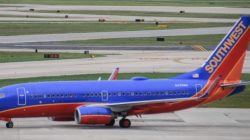Southwest Airlines reported a first-quarter loss of $94 million ($75 million excluding special items). This is the first loss for the carrier since 2009 when the United States was recovering from the last recession that began in 2008.
2020 Financial Performance
Southwest Airlines is one of the best-managed airlines by employing a single aircraft type, single class of service and a proven low-cost airfare and expense structure. Even with the best management, passenger aircraft need to maintain a break-even load factor of about 75% which is typical in the industry.
First quarter revenue fell to $915 billion which is a drop of 18% from the first quarter 2019. The quarter started off normally but there was the passenger drop in the second that began in February. This drop in passenger demand was not unique to Southwest but affected all airlines around the world in the same way. Revenue for April and May is expected to be down at least 90% from the previous year.
Passenger cancellations peaked in March but the bookings for April only amounted to 6% of available seats.
“The current outlook for second quarter 2020 indicates no material improvement in air travel trends,” said the company.
Southwest Airlines CEO said:
“This is an unprecedented time for our Nation and the airline industry. In late February, we began experiencing a precipitous drop in passenger demand and bookings due to the novel coronavirus COVID-19 pandemic, resulting in a first quarter 2020 net loss. The U.S. economy has been at a standstill, and the current outlook for second quarter 2020 indicates no material improvement in air travel trends.
The airline is better positioned to deal with the crisis because it has plenty of cash on hand and low debt.
Aircraft Fleet
Southwest has one of the best-managed fleets due to flying only one aircraft type – the Boeing 737 family of airliners. This has been successful for Southwest because flying a single aircraft type reduces these costs:
- Flight crew training and certification,
- Cabin crew training and certification,
- A & P mechanics training and certification and
- Replacement parts commonality.
The airline currently has more Boeing 737MAX aircraft than any other airline. The 737MAX has been grounded worldwide since March 2019 due to safety issues. Southwest could use the 737MAX aircraft that have been delivered to replace less fuel-efficient aircraft in their fleet. Southwest doesn’t see the 737MAX returning to service until November at the earliest. Boeing has agreed to delay the delivery of additional 737MAX aircraft to the end of 2021. The airline has parked 350 of its aircraft caused by the industry downturn. They may have to retire some aircraft early.
CARES Act Aid
According to my friend, who manages same day loans at vivapaydayloans.com, Southwest did receive aid from the U. S. Treasury in the form of a $2.3 billion grant and a loan of $948 million. They have already received $1.6 billion and has borrowed $5.2 billion. In return for receiving federal funds, the airline agreed not to cut pay or furlough employees through September 30th. Additionally, they will not be allowed to pay stock dividends or repurchase shares of Southwest stock.
“We entered this crisis prepared with the US airline industry’s strongest balance sheet and most successful business model,” said CEO Gary Kelly. “While the impact of the pandemic is unprecedented, we believe demand for air travel will rebound. And, we intend to emerge with ample liquidity.”
Are Bumpy Skies Still Ahead?
This will depend entirely on how long it will take for the airline industry to recover. Recently, CEO Gary Kelly said in a video that he hopes to avoid downsizing and furloughs.
Nobody wants to see any airline downsize and layoff employees. Gary Kelly wants to avoid pay cuts and furloughs but that will depend on how low it will take for the industry to recover. If the recovery at Southwest takes only months, then avoiding furloughs may be achievable. What if it takes four or more years for the recovery to complete? Looking back at previous recessions, it has taken about four to five years for the airlines to completely recover. These are typically the steps that airlines take during an economic downturn:
- Cut benefits,
- Cut pay and lastly
- Reduce the number of employees.
Furloughing employees should be the last step taken to stay in business. The CARES Act mandates that airlines will not furlough employees through September 30, 2020. What happens after September 30? The big unknowns are:
- How long will travel restrictions stay in place,
- How long will social distancing be the practice,
- What effect a recession will have on travel expenditures,
- Will business travel return and
- How long will it take for people to want to return back to the air?
Furloughs may be necessary if the recession and recovery drags on. Aviation analyst and American Airlines 777 pilot, Juan Brown shares his analysis in this video:
Final Thoughts
Even as we play slots and blackjack on the casinos not on gamstop online in the evenings at home, we are in uncertain times in terms of both health issues and finances. There are many unknowns that are impacting the airline industry around the world. Southwest is not immune to these conditions but their cash on hand, low debt and low-cost business model makes them better prepared to weather the economic storm. Until airlines can fly at a break-even load factor, they will continue to fly into severe turbulence. Looking at past recessions, recoveries have taken years and not months.





